If you’ve ever jumped into a noise control project, you’ve likely come across the terms “soundproofing” and “sound absorption”. I often see them used interchangeably.
But, this isn’t accurate. There are notable differences between soundproofing and sound absorption that dictate which is the correct term for your project.
In this article, I’ll explain why sound absorption, while it is part of soundproofing. isn’t soundproofing. Along with this, I’ll highlight the key differences and discuss some of the most useful soundproofing and sound absorbing materials.
Hopefully, by the end you’ll be armed with all the knowledge you need to jump into your project.
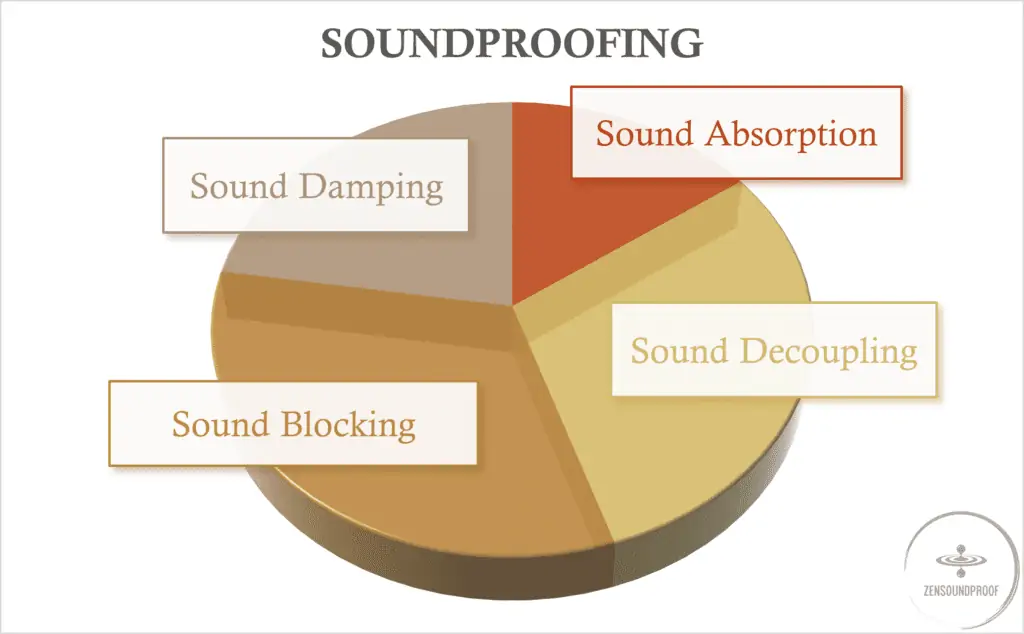
What is Soundproofing?
Soundproofing is the act of reducing or blocking unwanted noise in a space. This is what we generally mean when we refer to sound blocking. As the name suggests, it involves proofing an area against sound.
Soundproofing is an umbrella term that refers to a set of activities around reducing noise, much like how decorating refers to several tasks around changing a room’s appearance.
The type of soundproofing you use in a room depends on several factors. These include:
- The type of noise pollution (impact or airborne)
- The volume of the noise
- Your space’s setup (its walls, ceiling, etc.)
- Your space’s purpose (home theater, office, recording studio, etc.)
A room’s purpose is important for soundproofing because it dictates whether you want to stop sound coming in or getting out (or both). Knowing this will influence how you soundproof it.
Airborne Noise Vs. Impact Noise
I discuss the differences between airborne noise and impact noise in my post on how to soundproof a ceiling. Check it out if you’d like further information on the topic.
In short, the key differences are:
- Airborne noise is sound that travels through the air from a source. When talk with someone noise travels from your mouth to the ears of your interlocutor via air.
- Impact noise is sound resulting from an impact that travels through solid objects.

Why does this matter? Simply put, different soundproofing methods are more effective against different types of noise pollution (e.g., mass is useful for airborne noise but less so for impact noise).
The 4 Principles of Soundproofing
As I’ve mentioned, soundproofing is an umbrella term. Within this, we have 4 main principles to prevent sound from entering a space: sound blocking, sound damping, sound decoupling, and sound absorption.
Each of these does something different when soundproofing and are useful in different scenarios. Let’s consider them in more detail.
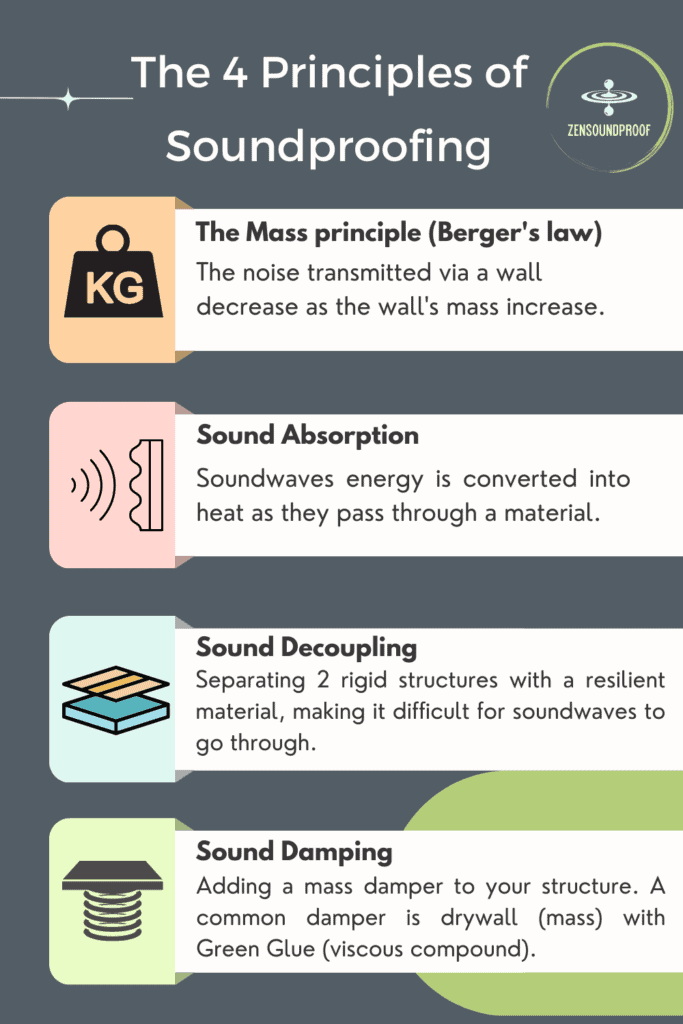
1. Mass (aka. Sound Blocking)
Adding mass to a structure makes it more difficult to vibrate. It means sound waves traveling through the air (i.e airborne sounds) will struggle to go through the structure. Using heavy materials won’t work against impact noise though.
Heavy materials act as a sound barrier against airborne noise. Thicker, heavier materials are better suited to block sound.
The rule is for every doubling of mass, a barrier will reduce sound by 6dB. For example, if you had a 6″ concrete slab blocking 51 dB, a 12″ slab would block 57 dB.
Examples of Sound Blocking Materials. Anything with high enough mass could be considered here. But our main options for adding mass using a dedicated sound blocking material include: Mass loaded vinyl or Sound deadening mats
On its own, mass is effective but not enough to soundproof a room. It’s one of the easiest principles to apply, though, and so is popular with amateur soundproofers.
2. Sound Damping
Sound damping is the act of preventing vibrations from building into sound waves. If you ring a bell it’ll continue making noise after you stop. But if you put your hand around it, it’ll stop. This is sound damping.
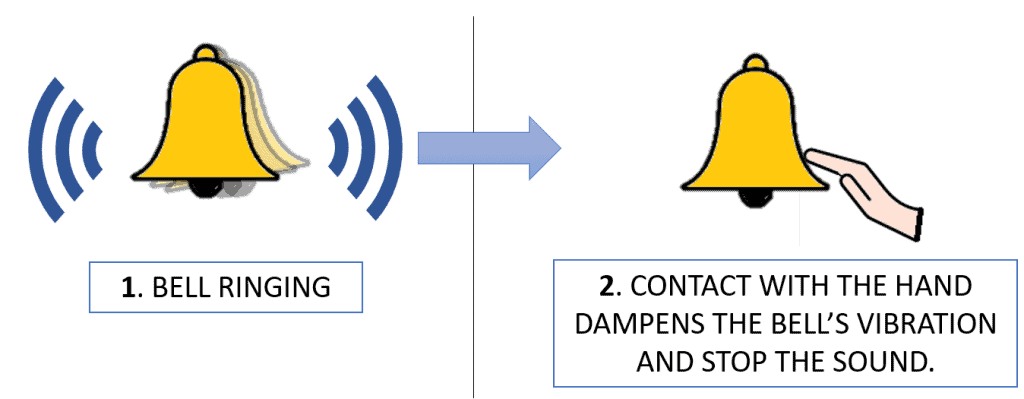
You can check out this video on sound damping materials for more information. It even includes a comparison with sound absorbing materials, which is helpful.
One of the most popular sound damping materials is Green Glue. It’s a visco-elastic compound, which means it never fully hardens. As a result, it converts vibrations into heat energy rather than transmitting them. It’s very effective against both impact and airborne noise. It also works great to dampen low-frequency noise like bass beats or construction noises.
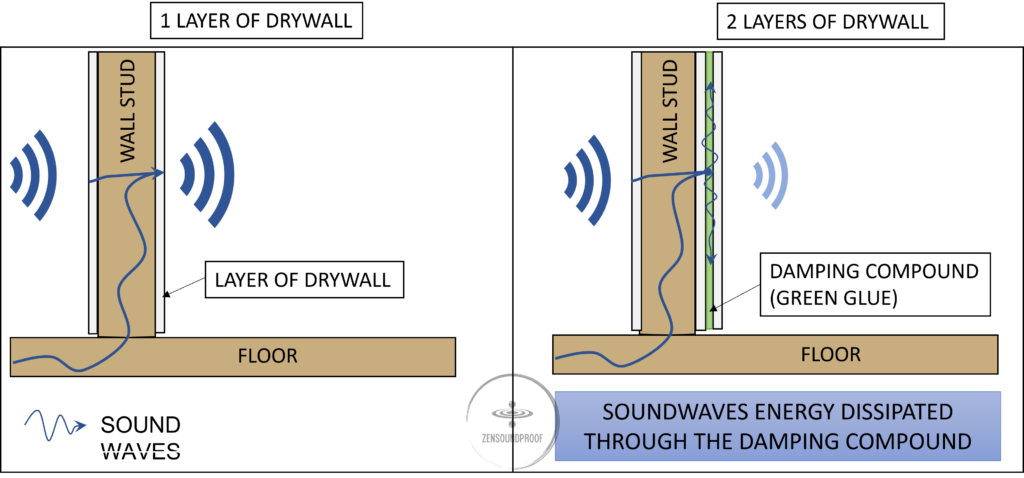
3. Sound Decoupling
On its own, decoupling is probably the most effective soundproofing principle. Also known as mechanical isolation, it involves inhibiting the path of sound waves through a mechanical path (such as wall joists).
Decoupling is another example of sound blocking because you’re physically stopping the sound waves from transmitting through a structure.
There are various methods for decoupling a wall, including building 2 sets of studs and filling the cavity with insulation. But this method requires lots of construction.
Instead, the more popular method is to use resilient channels and sound isolation clips. In short, resilient channels and isolation clips separate the drywall from the joists, meaning sound waves can’t transmit as easily. In itself, decoupling is meant to work against impact noise. But one side effect is that it adds layers to your structure meaning it’s also effective against airborne noise
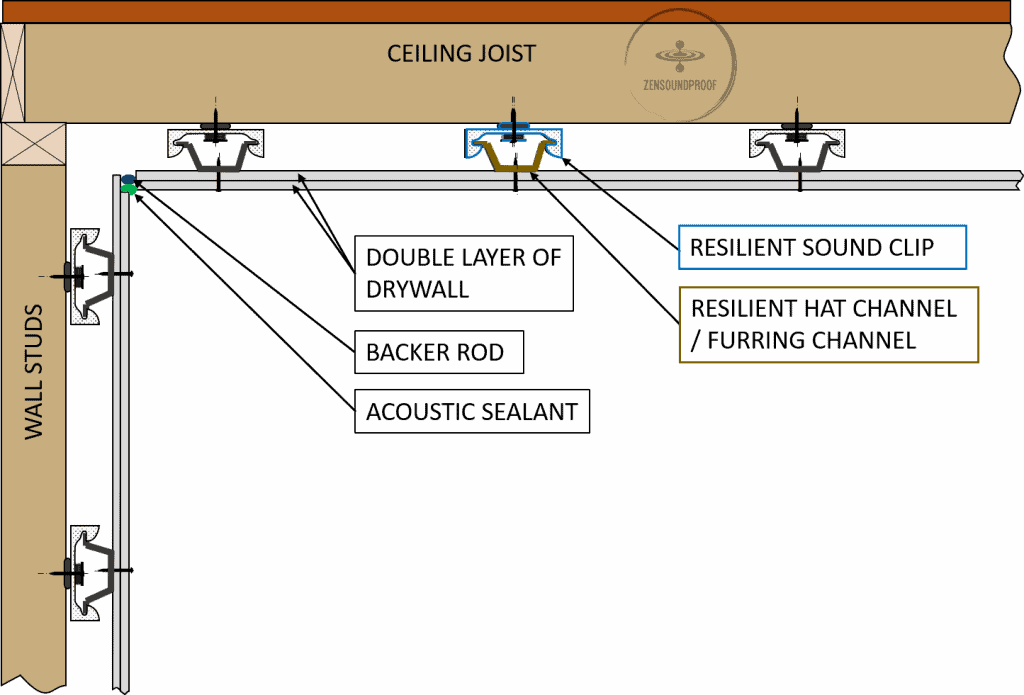
Check out this video on resilient channels for a clear demonstration.
4. Sound Absorption
Now we arrive at the important one: absorption. Sound absorbing materials convert sound waves into heat energy, reducing their amplitude (volume).
Sound absorption doesn’t block sounds; it reduces them.
We’re better off thinking of sound absorption as sound management rather than sound blocking. It’s used to control echo and reverberation to improve the audio quality in a space.
A typical sound absorbing material is porous (has an open structure). This allows sound waves to enter and expend their energy trying to get the material’s fibers to vibrate.
Eventually, sound waves lose some of their energy as it’s converted into heat. In the process, we consider part of the sound wave to have been absorbed.
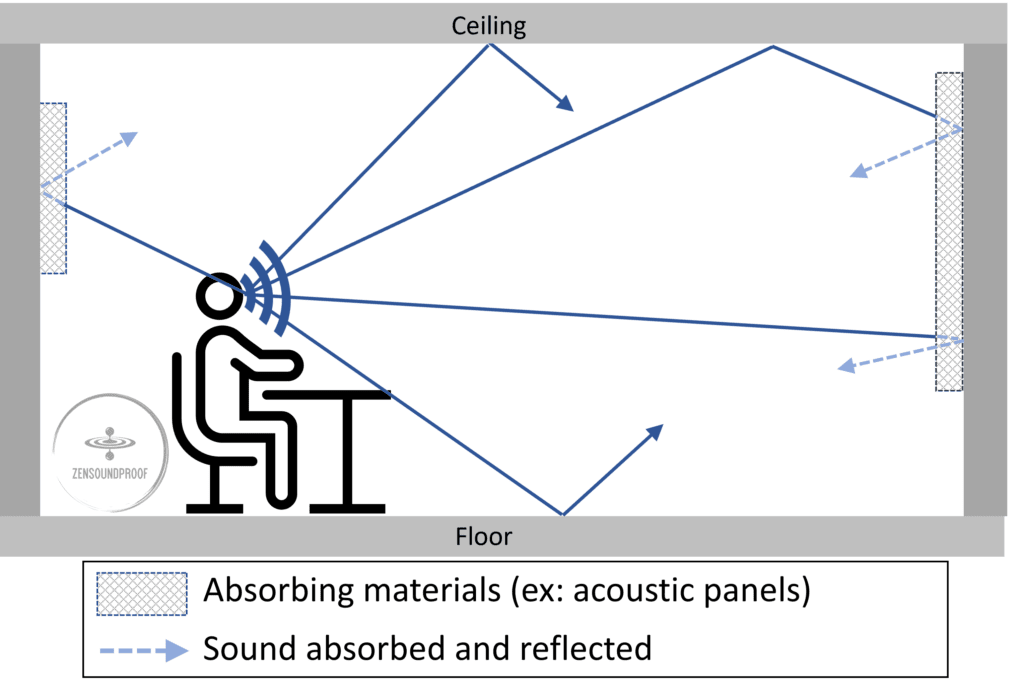
So, sound absorption belongs to soundproofing but isn’t the same thing. The other 3 principles are about prevention, whereas absorption is about management.
While absorption isn’t about blocking sound waves, it’s still useful in a soundproofing project. For example, if we’re able to absorb some sound waves then there are fewer to transmit through a structure.
But if you considered using only absorbing materials to make a wall, sound would still go through it. The porous nature of absorbing material doesn’t block noise but rather makes sound more muffled on the other side of the wall.
Effective soundproofing relies on a combination of these 4 principles in various capacities. How you approach the project depends on the space and what you want to achieve.
| Effective against Impact noise | Effective against Airborne noise | |
|---|---|---|
| Mass | Yes | |
| Damping | Yes | Yes |
| Decoupling | Yes | Yes |
| Absorption | Yes |
Sound Absorption Vs. Soundproofing
The main difference between sound absorption and soundproofing is purpose. Sound absorption controls echo and reverberation, whereas soundproofing focuses on blocking sounds from entering or leaving a space.
Of course, this isn’t the only difference, but it affects the others. For example, another key difference is placement within a room. Sound blocking materials are built into a wall, ceiling, or floor. Sound absorbing materials go in cavities or within the room itself.
When to Use Sound Absorbing Materials
You’d find sound absorbing materials in the following places.
Wall Cavity
A wall cavity is an empty space between 2 sheets of drywall. As a result, it’s an ideal place for sound waves to resonate and echo.
Filling the empty space with a sound absorbing material helps to reduce resonance. In turn, this reduces transmission between the 2 walls because the sound waves lose energy trying to pass through the material.
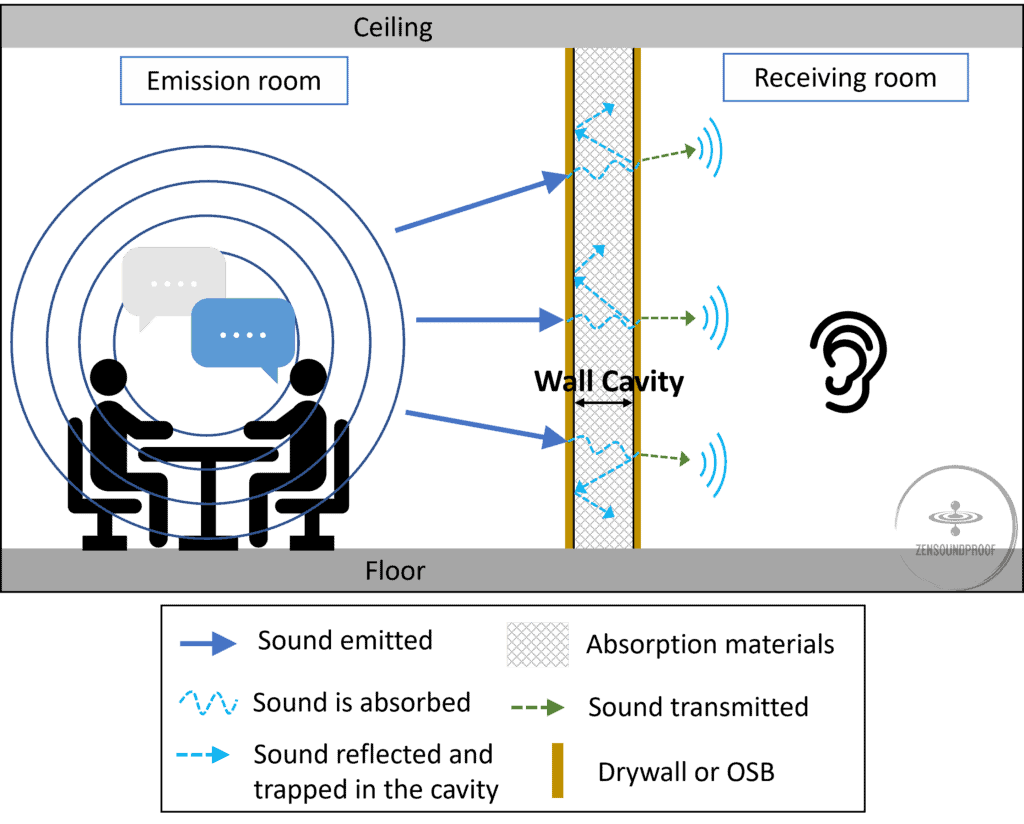
For wall cavities, you use denser sound absorbing materials so they add an element of sound blocking too.
Inside the Room
Acoustical materials are popular inside rooms if you want to control the sound quality. If you’ve ever seen the inside of a recording studio, you’ll know what this looks like.
But soundproofing panels of this kind are also popular in restaurants, theaters, and other public spaces. If the space is large and likely to have a lot of people, you can be sure there’s some kind of sound absorbing material in there.
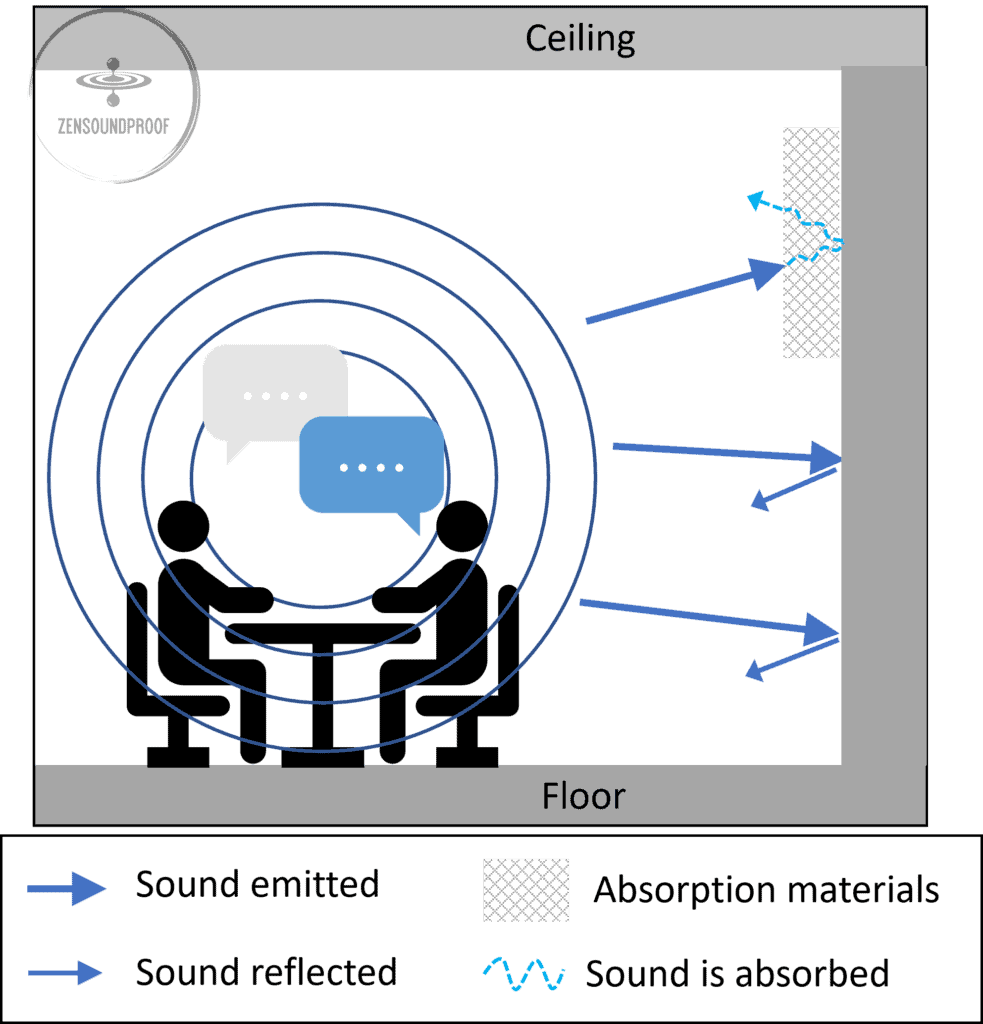
For acoustic management in a room, we use more porous absorbing materials. This is because we don’t need any sound blocking within the space, as absorption is much more important.
Placement of Sound Absorbing Materials
For best results, proper placement is vital. There’s no reason to approach acoustic management randomly because it relies on some simple science.
Consider these points when planning where to put your sound absorbing foam in your room.
Where to Place?
Placement depends on what frequencies you’re trying to absorb. For example, bass traps for low frequencies go in corners. This is because room corners are perfect reflection points for bass frequencies.
For mid- and high-frequency sound waves, we start with the first reflection point.
This is where sound waves first reflect off a wall, known as the mirror point. In a standard room, it’ll be directly opposite your speakers. Adding sound absorbing materials here will make the rest of the job much easier.
I recommend watching this video for a visual demonstration on first reflection points.
Unless you have a very large room or need an impossibly quiet vocal booth, the corners and first reflection points should be all you need.
Adding too much sound absorbing material into a room can make it feel acoustically dead and claustrophobic.
How Much Do I Need?
The amount of sound absorbing materials you need depends on the size of your room. As a percentage, it can be anywhere up to 80% of the wall space.
But for something like a home studio or home theater, up to 30% wall coverage should be enough.
This is because placement is far more important than amount. Providing you add bass traps to the corners and cover first reflection points, there’s little else you’ll need to do.
For a specific answer, consider using an acoustic panel area calculator.
Also, the best way to know for sure is to test the sound quality in your space. Walk around the room and clap loudly. If you’re happy with the level (or lack) of echo, you’ve got enough acoustic treatment.
6 Types of Sound Absorbing Materials
There are plenty of sound absorbing materials, from acoustic foam to soundproofing panels. The best products have a high NRC rating, which I explain in my post on how to reduce echo in a room.
Here are some examples of sound absorbing materials.
1) Acoustic foam
Also known as soundproof foam, this is the go-to for sound absorbing. It has a porous, open-celled structure and is ideal for high and mid-range frequencies. You can buy acoustic foam tiles online quite easily, and these are the best thing for managing acoustics in a room.
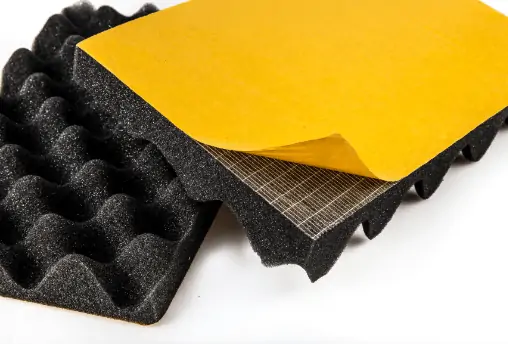
Does Soundproof Foam Work?
If your goal is to absorb sound waves to reduce echo, then yes, soundproof foam does work. Its open structure traps sound waves and effectively converts them into heat energy. Standard acoustic foam has an NRC rating around 0.4, which is fairly good.
2) Bass Traps
Bass traps are a sound absorbing material specifically for low-frequency sound waves. They’re made of the same kind of foam but in a wedge shape. Within this wedge are peaks and valleys, which is a better shape for absorbing bass frequencies.
For best results in a room, you’ll want to use a combination of bass traps and acoustic foam panels.
3) Fiberglass Insulation
Fiberglass is a thermal insulator but also works well against sound waves. Its open structure traps sound waves and converts them into heat energy, much like acoustic foam does.
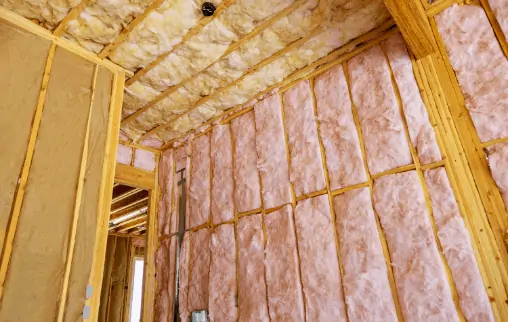
Depending on its thickness, fiberglass can have an NRC rating up to 0.95.
We typically use it for insulating wall cavities rather than inside rooms. This is because fiberglass is a hazardous material, as the small fibers can irritate your skin and lungs.
So, be sure to protect yourself when installing it!
4) Mineral Wool Insulation
Mineral wool is essentially fiberglass but is instead made from spun mineral fibers. Popular brands include Roxul and Rockwool.
It’s a good sound absorber for the same reason as fiberglass. It reduces reverberation inside wall cavities because it’s relatively porous yet dense.
As with fiberglass, mineral wool can have an NRC rating up to 0.95.
Again, we’d usually use it in wall cavities because the fibers are irritating to the skin. But you can box it in with lumber and turn it into an acoustic wall panel.
5) Acoustic Insulation Board
Some companies sell soundproofing panels that combine a sound absorbing material with a sound blocking material. These are known as composite products.
They might seem useful, but often aren’t worth the extra cost. You’re better spending your money on the raw materials and arranging them in the room as needed.
But something like Audimute’s Sound Absorption Sheet is quite effective. While its dimensions won’t be enough to cover an entire wall, it will cover a door or window.
6) Soft Furnishings
While these should never be your first option if you’re soundproofing a recording studio or home theater, common household items help to absorb sound waves. These include:
- Cushions
- Blankets
- Rugs and carpet
- Curtains
- Fabric wall hangings
- Sofas and chairs
Your furniture, carpets, and curtains generally provide enough sound absorption to prevent annoying reverberation from happening and to keep speech intelligible.
If you’ve ever moved house and have experienced an empty room versus a furnished one, you’ll know how much of a difference this can make.
Conclusion: Using Sound Absorption
Hopefully, you now understand the difference between soundproofing and sound absorption.
Soundproofing is the umbrella term to which sound absorption belongs. Rather than blocking sound, sound absorption is about managing acoustics within a space.
But it’s worth noting again: effective soundproofing uses a combination of all principles.
Let me know in the comments below if you have any go-to sound absorption tips.

2 thoughts on “Sound Absorption is NOT Soundproofing: Differences Explained”
Hi,
I was wondering if you could assist with 2 questions?
I am wanting to provide extra soundproofing to a double brick party wall in my garage. The brick party wall adjoins my neighbour’s bedroom.
I am in the process of building a stud frame (10 inches away from the brick party wall) in which I will install acoustic batts and then two layers of drywall over (maybe green glue between the drywall layers).
Q1 / Given I do not know what construction methods have been used on the other side of the brick party wall (i.e. stud wall with drywall) will my new decoupled stud wall create a ‘triple leaf effect’ if there is indeed another stud wall on the other side of the party wall?
Q2 / Do I require resilient channels on the stud frame if the new stud wall is 10 inches away from the brick party wall?
Any advice would be greatly appreciated.
Cheers Alex
Hi Alex,
A1 / That’s possible it creates a triple leaf effect. It might feel awkward, but it’s worth asking your neighbor if they know the composition of their side of the wall.
If they do have an air cavity on their side (meaning a stud frame + drywall for example), then you don’t have much options than dealing with a triple layer wall: the your stud wall + the brickwall + your neighbor’s stud wall.
All is not lost, because as much as triple leaf effect is really nefast when you consider 3 leaves of drywall (i.e. drywall + stud + drywall + furring + drywall), it’s different for concrete walls and brick walls.
This publication (page 28 and 29) from the Conseil National de Recherche du Canada shows that for concrete block walls, there are configuration that improve overall STC.
In the Doc, the wall assembly TL-88-358 and TL-88-397 have respectively an improvement of STC of +9 and +19.
A2 / In your case, adding resilient channels on your stud frame will help increase the air gap, air gap in this double or triple leaf layout is a preponderant factor. So, I would increase any setup that can push your “leaves” as far from each other as possible.
I would also encourage the use of Greenglue as you mentioned.
I hope it helps and sorry for the late answer.
Cheers,
Ludovic